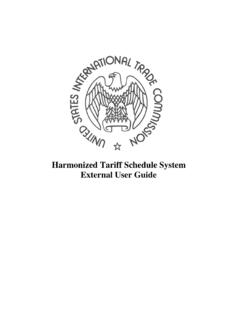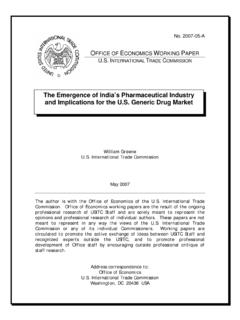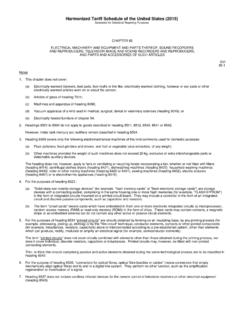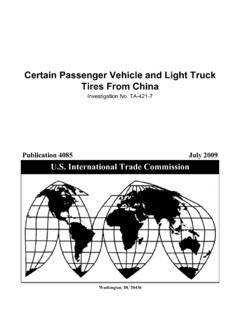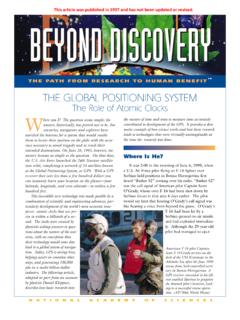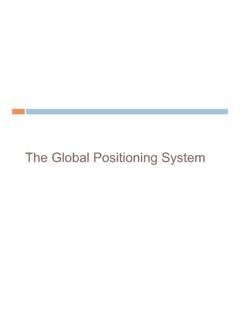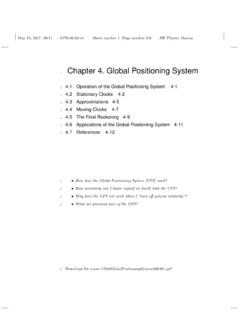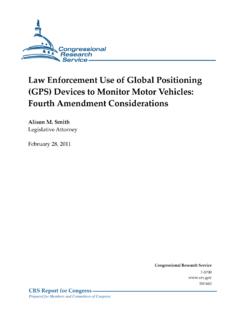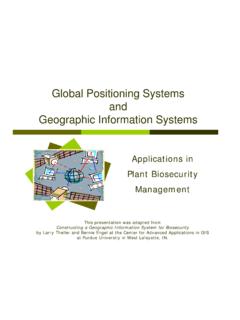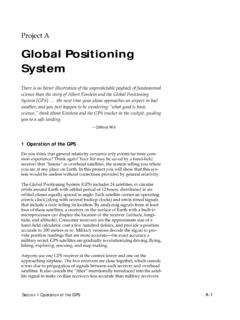Transcription of THE GLOBAL POSITIONING SYSTEM: GLOBAL …
1 THE GLOBAL POSITIONING system : GLOBAL DEVELOPMENTS ANDOPPORTUNITIESID-06 OFFICE OF INDUSTRIES WORKING International Trade CommissionJames M. BrandonOffice of International Trade CommissionMay 2003 The author is with the Office of Industries of the International Trade Commission(Commission). Office of Industries working papers are the result of the ongoing professionalresearch of the Commission staff and represent the opinions and professional research ofindividual authors. These papers do not necessarily represent the views of the Commissionor any individual Commissioner.
2 Working papers are circulated to promote the activeexchange of ideas between Commission staff and recognized experts outside theCommission, and to promote professional development of office staff by encouragingoutside professional critique of staff research. ADDRESS CORRESPONDENCE TO:OFFICE OF INTERNATIONAL TRADE COMMISSIONWASHINGTON, DC 20436 USAiEXECUTIVE SUMMARYB ackground The GLOBAL POSITIONING system (GPS), which is the world s most accurate method ofnavigation, was conceived to enhance navigation accuracy for military forces during theearly 1970s.
3 Since 1984, the GPS has found application in a myriad of systems fromautomotive monitors advising drivers of the locations of hotels and restaurants to guidancesystems which allow bombs and missiles to make direct hits on targets. Of the two globalsatellite navigation systems currently operating, the GPS has gained preference in mostinternational markets. The operation of the GPS relies on signals received from 24 NAVSTAR satellites, each ofwhich orbit in space about 11,000 miles above the earth s surface. These satellites revolvearound the earth twice a day (or once every 12 hours) and transmit signals to GPS receiverspositioned on or above the earth s surface.
4 GPS receivers, which process data emitted fromGPS satellites, compare the time the satellite signal was transmitted with the time the signalreaches the receiver. The receiver is then able to determine its precise distance from Government Policies On March 29, 1996, the President of the United States approved a comprehensive nationalpolicy on the future management of the GPS and related Government policy seeks to enhance the country s productivity and economic competitiveness whileprotecting national security and foreign policy interests. Based on recommendationsfrom the Departments of Defense, Transportation, and State, the policy requires the Presidentto make annual determinations regarding certain GPS operational Industry and Markets Japan, followed by the United States, is the principal GLOBAL supplier of GPS-related 1998, Japan accounted for 47 percent ($ billion) of the GLOBAL GPS market, whereas theUnited States represented 32 percent ($ billion).
5 Eighteen percent ($784 million) of theremaining market share was largely accounted for by European countries. Although theUnited States and Japan are comparable with respect to GPS manufacturing technology, theUnited States is generally believed to enjoy a slight lead in higher value-added products withan advanced software content. GLOBAL demand for GPS products grew significantly during 1997-2001, with total GLOBAL salesof such products increasing by 275 percent to $ billion. Car navigation, which is thelargest international market for the GPS, accounted for 34 percent ($ billion) of totalglobal GPS sales in 2001.
6 The consumer sector, which is the second largest market,represented 22 percent ($ billion) of such sales. The third largest market sector, surveyingiiand mapping, accounted for 16 percent ($ billion) of GLOBAL sales in 2001. Rising saleswere recorded in all market sectors during 1997-2001, and are projected to continue upwardduring 2002-03. GLOBAL Developments GPS receivers are available at a fraction of the price of a decade ago. Current prices of GPSreceivers may range from approximately $100 for a small, one-hand operated 12 channelreceiver to $2,000 for a deluxe color automobile GPS receiver capable of displaying routesand giving turn-by-turn directions and voice prompts to drivers.
7 Prices of receivers designedfor avionics, military equipment, and other sophisticated applications may by higher. Car navigation systems are continuing to grow in popularity in Asia, with Japan leading inoutput (about million units shipped in 2001) and product innovation. While CD-ROMshave been an essential software for car navigation, DVD-ROMs are now being usedextensively. Certain European countries, especially in Scandinavia, are taking a more entrepreneurialapproach to GPS technology by focusing on immediate applications in land survey, vehicletracking, geographic information systems, and coastal navigation.
8 In some instances this hasled to the acquisition of firms or technology, such as the transfer of the Magnavox sGPS product line to the Swiss firm Rapidly expanding GPS technology will continue to provide both and foreign users withtremendous capabilities in consumer, commercial, industrial, and military sales of GPS products are projected to total nearly $ billion by 2003, products accounting for 30 percent ($ billion) of those sales. The nextgeneration of GPS satellites, which are scheduled to be launched by 2005, will have increasedflexibility to accommodate new augmentations and auxiliary payloads, and larger processorand memory summary.
9 Evolution of operation policy addressing demand, sales, and principal markets ..10 Car navigation .. production and developments and America ..19 Asia-Pacific ..21 Europe ..22 Other regions ..23 GLONASS and ..26 Table 1: Major GLOBAL producers of GPS products; markets served; and location of producers 2: GLOBAL GPS sales by market segment, 1997-2001, and projected sales, 1: GLOBAL GPS market share projections ..12 1 The views expressed in this report are those of the author. They do not necessarily represent the views of International Trade Commission as a whole or any individual Commissioner.
10 Please direct all correspondenceto James M. Brandon, International Trade Analyst, Office of Industries, International Trade Commission, 500E Street, SW, Washington, DC 20436, telephone 202-205-3433, fax 202-205-2018, email: Theinvaluable assistance provided by Monica Reed and Wanda Tolson during the preparation of the report is gratefullyacknowledged. 2 Department of Commerce, International Trade Administration (ITA), Office of Telecommunications, GLOBAL POSITIONING system , Market Projections and Trends in the Newest GLOBAL Information Utility, ExecutiveSummary, p.
